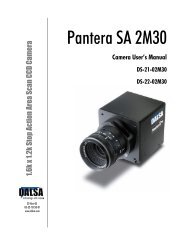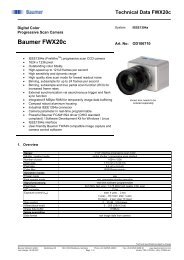Spyder 3 Camera User's Manual GigE Dual Line - Frame Grabbers
Spyder 3 Camera User's Manual GigE Dual Line - Frame Grabbers
Spyder 3 Camera User's Manual GigE Dual Line - Frame Grabbers
Create successful ePaper yourself
Turn your PDF publications into a flip-book with our unique Google optimized e-Paper software.
<strong>Spyder</strong> 3 <strong>GigE</strong> User’s <strong>Manual</strong><br />
75<br />
Performing PRNU to a user entered value<br />
Purpose:<br />
Syntax:<br />
Syntax Elements:<br />
Performs PRNU calibration to user entered value and eliminates the<br />
difference in responsivity between the most and least sensitive pixel<br />
creating a uniform response to light. Using this command, you must<br />
provide a calibration target.<br />
Executing these algorithms causes the ssb command to be set to 0<br />
(no background subtraction) and the ssg command to 4096 (unity<br />
digital gain). The pixel coefficients are disabled (epc 0 0) during<br />
the algorithm execution but returned to the state they were prior to<br />
command execution.<br />
cpa i i<br />
i<br />
PRNU calibration algorithm to use:<br />
1 = This algorithm first adjusts each tap’s analog gain so that 8-<br />
13% of pixels within a tap are above the value specified in the<br />
target value parameter. PRNU calibration then occurs using the<br />
peak pixel in the region of interest.<br />
This algorithm is recommended for use only when FPN is<br />
negligible and FPN coefficients are set to zero. Since this<br />
algorithm adjusts the analog gain, it also affects FPN. If FPN is<br />
calibrated prior to running this algorithm, FPN will be<br />
observable in dark conditions and an incorrect FPN value will be<br />
used during PRNU calibration resulting in incorrect PRNU<br />
coefficients.<br />
2 = Calculates the PRNU coefficients using the entered target<br />
value as shown below:<br />
Target<br />
PRNU Coefficient =<br />
i<br />
(AVG Pixel Value ) ‐ (FPN + sdo value)<br />
i i<br />
The calculation is performed for all sensor pixels but warnings<br />
are only applied to pixels in the region of interest. This<br />
algorithm is useful for achieving uniform output across multiple<br />
cameras. Is is important that the target value (set with the next<br />
parameter) is set to be at least equal to the highest pixel across<br />
all cameras so that all pixels can reach the highest pixel value<br />
during calibration.<br />
3 = This algorithm includes an analog gain adjustment prior to<br />
PRNU calibration. Analog gain is first adjusted so that the peak<br />
pixel value in tap’s ROI is within 97 to 99% of the specified<br />
target value. It then calculates the PRNU coefficients using the<br />
target value as shown below:<br />
Target<br />
PRNU Coefficient =<br />
i<br />
(AVG Pixel Value ) ‐ (FPN + sdo value)<br />
i i<br />
The calculation is performed for all sensor pixels but warnings<br />
are only applied to pixels in the region of interest. This<br />
algorithm is useful for achieving uniform output across multiple<br />
cameras.<br />
This algorithm is useful for achieving uniform output across<br />
multiple cameras by first adjusting analog gain and then<br />
performing PRNU calibration. This algorithm is recommended<br />
for use only when FPN is negligible and FPN coefficients are set<br />
to zero. Since this algorithm adjusts the analog gain, it also<br />
affects FPN. If FPN is calibrated prior to running this algorithm,<br />
DALSA 03-032-10158-06
















